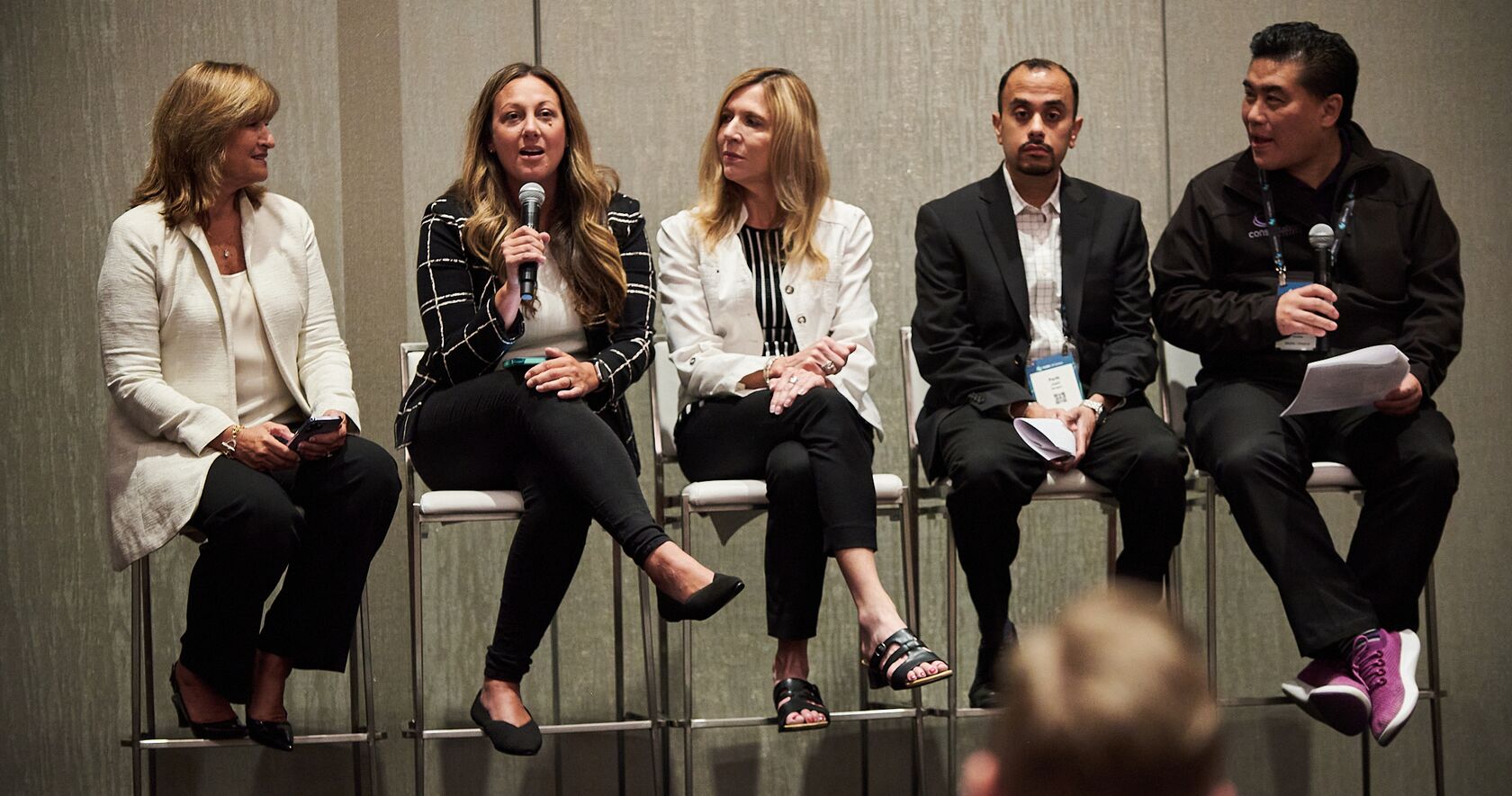Would you trust an automated doctor? What if the machine was consistently more accurate than a human practitioner?
As we enter an age where autonomy plays a greater role in every area of life, the world is learning to automate more tasks while addressing issues including human trust, labour shortages, compliance and return on investment (ROI). Will industries like agriculture, manufacturing and public safety fully embrace autonomy by 2030, and what will cities of the future look like when they do?
These topics were tackled by technology leaders at HxGN LIVE Global 2023. Moderated by Ray Wang, principal analyst and founder of Constellation Research, Inc., the conversations evoked inspiring insights on how autonomy has already been applied, where it’s headed in multiple ecosystems and why we should pay attention.
Addressing customer hesitation to introduce autonomy
Recognised as one of the top technology and business analysts in the world, Wang kicked off the panel discussion asking about the current state of tension as some industries remain reluctant to embrace AI technologies. Kalyn Sims, CTO, Hexagon’s Safety, Infrastructure and Geospatial division, said her customers in defence, utilities and public safety are often risk-averse – for a reason.
“Public safety is mission critical for them because lives are at stake,” she said. “So, they get a little nervous when you start talking about AI. We have to slowly introduce technology, but it’s getting there, and I think there’s a lot of opportunity.”
Other expert panelists agreed, including Melanie Eakes, CTO, Hexagon’s Asset Lifecycle Intelligence division. “It’s the same for our customers in industrial facilities. They’re risk-averse, because if something bad happens to their client, it can be bad for the whole community.”
To address the issue, Sims highlighted the importance of providing clarity around the AI/human relationship. “Artificial intelligence mines data and uncovers patterns and trends,” she said. “AI augments the dispatcher by alerting them of data they may want to analyse closer in order to make a timely, efficient and well-informed response.”
She described another new product, Smart Advisor, which offers the same approach in Manaus, Brazil. As a city of about two million people, Manaus set up a city cooperation centre to enable better cooperation between city organisations. Smart Advisor mines data from multiple sources, including surveillance systems, weather stations, Internet of Things (IoT) devices and sensors across the city. “It looks for patterns, similarities and anomalies, and when it finds one, it alerts the user. This provides them with insights they wouldn’t have had when determining how to respond to an emergency,” Sims said. “Our customers are still in control, and that is critical to the public safety industry.”
Automating the data deluge
The technology leaders also addressed the volume of data available in business and the challenge of sorting through it all. Nicole Waier, VP of Sales, Hexagon’s Autonomy & Positioning division, spoke about how her team uses precise positioning technology with farm vehicles to boost autonomy in agriculture. “When you look at the sensors around the vehicle – cameras, LiDAR, radar – they are often generating terabytes of data during the development of algorithms. The data must be collected and turned into software to make those cars autonomous.”
Each panelist had an example of big data’s impact on their industries. Sims said the data deluge is a big problem for smart city implementations. Parth Joshi, CTO and CPO, Hexagon’s Manufacturing Intelligence division, shared how this overflow of data affects the manufacturing industry. “Every inquiry builds up data. Our platforms have to figure out what to do with that data and make workflows for automating it.”
As a solution, Joshi said his customers are embracing lights-out manufacturing. “Lights-out manufacturing is having equipment that collaborates with each other – cobots, robots, automation. Through open-system platforms, data collection insights are able to immediately feed back to the production lifecycle.” He said technology like Nexus makes this possible for large corporations. By aligning internal functions, Nexus helps push autonomy to develop more efficient, seamless manufacturing operations.
Eakes shared how her team empowers customers to make data-driven decisions by automatically visualising information with products such as HxGN SDx®. “Our strength is creating virtual representations of a physical asset. Then we infuse those assets with intelligence from connected systems of record,” she said. “That connection enhances our customers’ work processes. They can now see information and data attached to it, allowing them to make much smarter decisions faster.”
Combating knowledge gaps and the labour shortage
Wang introduced the current labour shortage for discussion. “From a macro perspective, skill and labour shortages are driving industry change. Autonomy is playing a huge role in that already.”
Joshi offered his perspective from the manufacturing space. “In the time since COVID, we figured out that manufacturers can’t hire talent as fast as they need to, or there are only a few people they can teach to take on these skills,” he said. “Autonomous solutions for manufacturing facilities offer better efficiency through automated production lines and designs.”
Eakes discussed the knowledge gap as four million people have left the workforce since 2019. “We’ve got facilities that have been around for decades, and the employees from those facilities have a lot of knowledge in their heads,” she said. “You bring in a new hire, and they don’t know any of that.”
She aims to help her customers understand how important it is to digitalise not only their data and facility info but also their work processes and procedures. “When you combine those two things, a new person can see exactly what they need to do with step-by-step instructions. It gives them confidence,” she said. “Now, suddenly, these new employees know exactly what to do when something bad happens. Digitalising processes and procedures can help new employee onboarding become a lot simpler.”
Waier illustrated the labour shortage by addressing how autonomous vehicles could impact future cities, starting with off-road hauling. “The city of the future is more spread out, and people won’t want to drive big trucks to haul things out to remote areas and live there for weeks at a time,” she said. “An autonomous vehicle solves both problems – those cities can now stay closer together, even if work is further away, and people don’t have to move away from their families.”
She mentioned the opportunity for dedicated shuttle lanes in cities where precise positioning allows autonomous vehicles to move people and cut down on traffic. “Hopefully, that means more parks for us in areas where parking garages are needed for commuters and less traffic on the road for the rest of us,” she said.

Advancing sustainability through autonomy
Autonomy continues to offer exciting opportunities for innovators and industries – especially regarding sustainability goals for city and nation planners. Sims discussed the power of digital twin solutions in sustainability. “Digital twins let us detect problems, then run assessments and an endless number of simulations to see how to solve those problems,” she said.
Examples such as Spain’s first digital twin in Campo de Cartagena show the positive impact that environmental issue simulations deliver. “Through digital twin scenario planning, we’re able to show visual comparisons over time, such as changes in vegetation and water tables in built environments,” she said. “And this allows our customers to plan ways to proactively prevent flooding, pollution and issues arising from climate change.”
Sims shared how Cologne, Germany, is streamlining waste-water operations by improving their tax assessment procedures. Sims said, “Currently, assessments have to be done manually, which leads to inaccurate and unfairly distributed tax assessments. By using imagery, LIDAR-based data collection and AI-enabled analysis, the city is able to replace labour intensive processes by automatically detecting changes in paved surfaces that affect drainage. The result is more accurate tax assessments, more efficient management of the waste-water collection and a 90% improvement in time and labour.”
This conversation highlighted how our customers are paying attention to, and adopting, autonomous solutions into their workflows. As for the future, more improvements and innovations in AI will lead to a higher level of autonomy across industries. “What we’re accelerating every day is AI’s ability to understand pattern recognition,” Wang said. “Once enough data is mined and scenarios simulated, the next level of autonomy will be reached in most workflows.”
The panel exemplified how Hexagon equips customers across multiple industries with the tools they need to prepare for and embrace an increasingly autonomous future. As leadership envisions 2030 and beyond, our technology will continue to evolve to help customers build sustainable systems and foster innovation in their workflows.

















